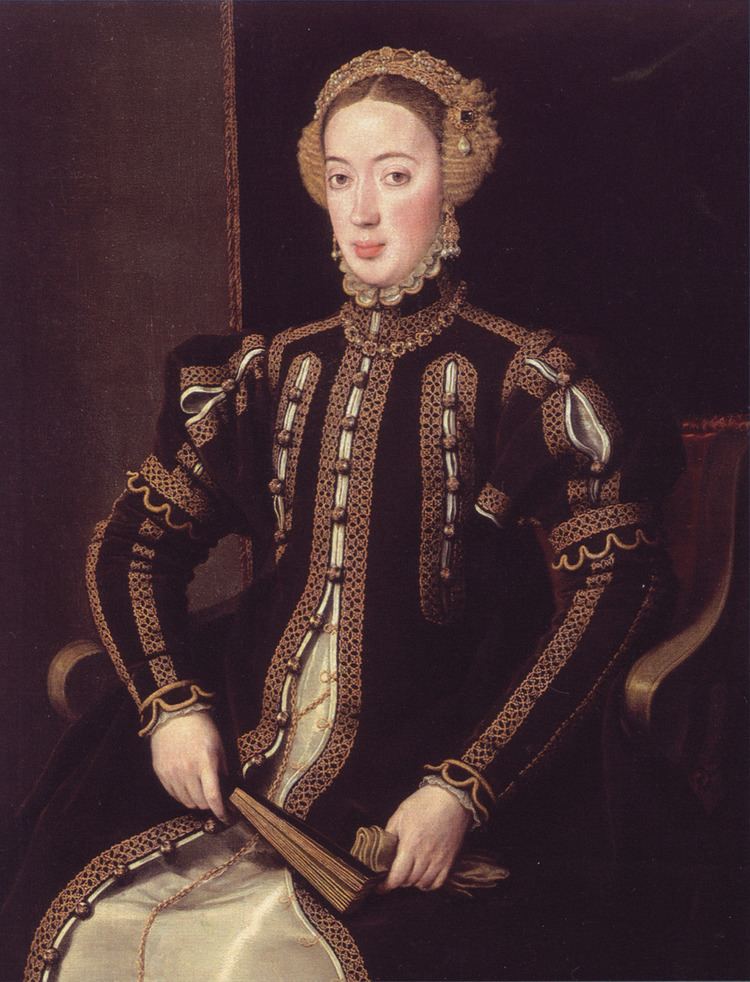Name Maria Portugal, | Religion Roman Catholicism | |
 | ||
Parents Eleanor of Austria, Manuel I of Portugal Siblings John III of Portugal, Isabella of Portugal Cousins Philip II of Spain, John of Austria, Maria of Austria - Holy Rom, Margaret of Parma, Joanna of Austria - Princess Similar People Manuel I of Portugal, Eleanor of Austria, John III of Portugal, Maria of Aragon - Queen of, Isabella of Portugal | ||
D. Maria of Portugal, Duchess of Viseu (18 June 1521 – 10 October 1577 in Lisbon; [mɐˈɾiɐ]) was an Infanta of Portugal, the only daughter of King Manuel I of Portugal and Eleanor of Austria. A noted patron of the arts, Maria's personal wealth rivaled that of the king, her brother (John III of Portugal), making her the richest woman in Portugal and one of the richest in Europe.
Contents

Biography
Maria was born on June 18, 1521 in Lisbon. In December the same year, her father died and her half-brother John III became king. Shortly afterwards, Maria's mother, the dowager queen Eleanor, returned to her brother's court in Vienna, taking Maria with her.
In 1530, Eleanor married King Francis I of France and moved to France. Maria would not see her mother for nearly 28 years. Meanwhile, in 1525, Eleanor's younger sister (Maria's aunt) Catherine had married Maria's half-brother John III of Portugal. At some point, Maria moved from Vienna to Lisbon. She was to live in Portugal, at the court of her half-brother and his family, for the rest of her life.
Marriage considerations
In 1537 Maria was briefly considered, along with her cousin Christina, Dowager Duchess of Milan, as a bride for Henry VIII. However, Christina was considered more suitable, and England dropped any pursuit of Maria. She was at one point considered as a second wife for her nephew and cousin (the future Philip II of Spain). Philip was the son of Maria'a half-sister Isabella of Portugal. Also, Maria's mother, Eleanor, and Philip's father, Charles V, were siblings. The matter was taken to serious consideration from 1549 onward, when her mother, the queen dowager Eleanor of France, settled in Brussels and started to support them. However, these plans were discontinued when Mary Tudor succeeded to the English throne in 1553, and the Emperor Charles V decided to marry his son Philip to her.
Later life
In 1556, Eleanor (now again widowed and with no other living children) retired to Jarandilla de la Vera in Spain with her sister Mary. In 1558, both mother and daughter traveled from their respective residences to the town of Badajoz on the Luso-Hispanic border and met after a gap of 28 years. Eleanor asked the unwed Maria to come and live with her. Maria refused the request and only remained with her mother for three weeks before returning to Lisbon. Eleanor died very shortly afterwards, on her return journey to Jarandilla de la Vera from Badajoz.
Maria died unmarried and childless in Lisbon on October 10, 1577. She is buried in the Church of Nossa Senhora da Luz.
Patronage
Maria is often referred (like her mother) as a protector of the arts and writing. She sponsored several building projects, particularly in Carnide, then a village in the Lisbon countryside. There she was patron to the building of the Church of Nossa Senhora da Luz and the Hospital of Nossa Senhora dos Prazeres, which currently houses the Colégio Militar, both of which still boast large reliefs of her personal coat of arms.
In Lisbon, D. Maria sponsored the construction of the Church of Santa Engrácia, in São Vicente. The original structure she ordered to be built would be completely destroyed in 1681, which would lead to the construction of the new, and current, church, which now serves as the National Pantheon of Portugal.
